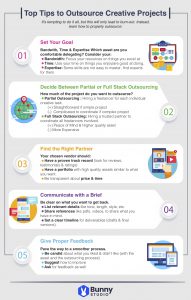As an entrepreneur, it’s tempting to do it all.
After all, it’s the best way to make sure you’re in control of the quality of your product. However, doing too much often leads to burn out. That’s where creative outsourcing comes in, or at least, should.
Creative outsourcing frees up your time, make you so you can concentrate on what matters: growing your business.
But as many of you already know, creative outsourcing can be heaven or can be hell. What should equal freeing up some time, can easily end up taking up more time than you even began with.
Thankfully, if you know which steps to follow when outsourcing your creative needs, this entire process can be a walk in the park.
That’s why we went back through our files, found some patterns and asked around for the best tips for outsourcing your creative needs, and made them into a nice PDF – which you can download here.

If you are interested in digging a little deeper, then please, read along.
If you prefer to watch a video instead, click here:
This post has been updated in August 2021.
These are our Top Tips to Outsource Creative Projects:
1. Set Your Goal
The first step is deciding which asset you would be comfortable delegating to a third party. Some things to consider when you’re doing this:
- Bandwidth: Is this something you already have, or do you need to allocate a budget to acquire it? Is it worth the time, money and effort to purchase, or would your needs be served just as well by outsourcing?
- Time: Time is a finite resource, so don’t waste yours doing something you dislike!
- Expertise: Some skills, like motion graphics or illustration, are not easy to learn. Here’s where you could benefit from the services of a professional.

2. Decide Between Partial or Full Stack Outsourcing
How much of the project do you want to outsource?
Do you need help with a little or a lot? What can you do? What should you do?
In most outsourcing projects, you generally have two options:
Partial Outsourcing
Partial outsourcing means hiring a freelancer for each individual creative task.
You might have to coordinate or merge multiple deliverables into one asset.
For example, to create a video you hire a copywriter for the script, a VO artist to record, a designer for images and a video editor to put everything
together.
- The Pros:
- For specific tasks like a single design or copy for an email, this a good option.
- The Cons:
- For more complex tasks, it will require more of your time to coordinate between different people doing different tasks.
- You might feel overwhelmed, and there is a risk of losing quality.
Full Stack Outsourcing
Full-stack outsourcing means hiring a trusted partner to execute complex creative projects from beginning to end.
For example, to create a video, you hire a creative producer who takes care of all tasks, from the script to the final video edit.
- The Pros:
- There is definitely more peace of mind with this option, and the asset would be of higher quality.
- The Cons:
- It could be more expensive.
The thing is, if you want to
3. Find the Right Partner
Whether you’re choosing to Partial Outsource or Full-stack Outsource, there are many vendors out there doing quality work. Here’s what to look out for to find the best one for you.
Your trusted vendor should:
- Have a proven track record of successful projects and clients – look for testimonials, ratings or reviews.
- Have a portfolio that shows off the high-quality assets they’ve produced.
- Be transparent about price & time: they should be able to provide an upfront quote for your project and specifications of how long it will take.
- Be highly responsive and detail-oriented.
4. Communicate with a Brief
Found your perfect vendor? Great, now it’s time to precisely say what you need.
Here are some useful guidelines:
- List all relevant details, like tone and manner, style and length.
- Share all the references like blog posts, videos, pdfs to effectively share what you have in mind and illustrate it visually as well.
- Set a clear timeline for deliverables so your vendor has a clear goal to work towards. Follow up with meetings or emails to keep track of deliverables.
- Make sure your vendor knows that the contract includes asset revisions because you may want to make changes.
- And when you’re requesting for changes, try to compile feedback from all relevant parties before forwarding it along; this helps to make the process smoother with less confusion.
5. Give Proper Feedback
Feedback is a crucial step that helps your creative agency know you and your expectations better.
It will help them learn what your brand is about, and it also makes it easier for them to provide references and work that is tailored specifically to you. So, the more detailed and honest feedback you can provide, the better.
This is the secret key to conquering your creative outsourcing goals, especially in the long term, so don’t be afraid to be as candid as possible.
That’s it! If you follow our Top Tips to Outsource Creative Projects, you should be good to go with all of your creative needs. Because at Bunny Studio we believe that outsourcing should be hassle-free, and easy-going. But to achieve this, you do need a little input on your end.
Outsource your creative project today with Bunny Studio.











